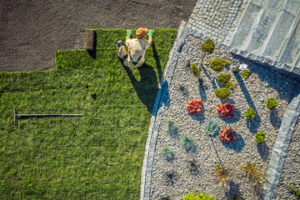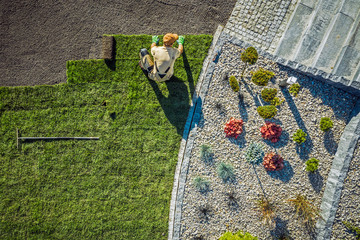Landscaping is the process of designing and constructing outdoor features like gardens, driveways, walkways, fences, walls, and patios. It also includes the addition of trees and plants.
Different elements of the landscape should work together to create a unified look. This can be achieved through unity, proportion, scale, and contrast. Visit https://www.jupiterlandscaping.net/ to learn more.
The design phase of landscaping involves creating a plan for the appearance of a property’s outdoor spaces. This includes determining the layout of plants, adding walkways and other hardscaping elements, and creating a focal point that draws attention to the landscape. A well-planned landscape can increase property value, add curb appeal, and improve the overall quality of life outside the home.
While there are many ways to achieve a desirable exterior, the basics of landscape design include proportion, simplicity, and unity. It also requires regular trimming and maintenance to keep the plant materials looking their best.
When designing a landscape, it is important to think about sun and wind patterns in order to ensure the safety of the homeowners as well as the longevity of hardscaping and softscaping materials. For example, a patio or pergola might be ideal for relaxing in the evening but it could be dangerous during a high-wind storm. It is also important to choose materials that can accomplish multiple functions, such as a rain garden that both looks good and manages water runoff.
To give your yard more dimension, use layers to create depth. Incorporate a combination of tall, medium, and short plants that create visual interest. This is especially effective if you mix in flowering plants and shrubbery with a variety of colors. Focalization is another way to draw the eye of the viewer and can be accomplished by using a statue, fountain, or other water feature.
Hardscaping is a big part of landscape design and can involve paths, patios, walls, and decorative stone features. Choose materials that match the style of your house to create a cohesive look. For example, a formal garden uses trimmed hedges and classic planting styles while a natural landscape uses native plants and organic shapes.
To create a more aesthetically pleasing backyard, consider adding a fire pit or dining area to your landscape. This will make it easier to entertain guests and enjoy the outdoors while still being close to the kitchen or living room. For a more modern touch, use lighting to highlight your hardscaping and landscape elements. This is a great way to add curb appeal to your home while also improving the safety of your family and visitors.
Materials
When it comes to landscaping, quality materials are essential. Whether you are a homeowner looking to transform your garden, or a contractor building a project site, you need to have the right tools and supplies for the job. SiteWorx offers a large selection of landscaping materials that will suit your needs. We carry everything from mulch, sand, and gravel to rocks, stone, pavers, and much more. We can also provide you with the right equipment to properly install your landscaping projects as well.
Mulch
A common element in many gardens, mulch suppresses weeds and helps the plants retain moisture. Mulch is available in a wide range of colors and textures to match the look of your landscape. Some mulches are dyed or scented for an added aesthetic appeal.
Landscaping stones
Decorative rocks add contrast, texture, and visual interest to any landscaping design. They work especially well with naturalistic or xeriscape designs. Boulders are popular choices for focal points or to create borders and edging for flower beds. Sand is useful for amending soil to improve drainage and for creating certain types of gardens, such as cactus or succulent gardens.
Concrete and pavers are commonly used for walkways, patios, driveways, and other hardscape features. They are often stained, stamped, or textured to enhance their appearance and offer improved traction compared to a smooth surface.
Wood is a versatile material that can be used for numerous landscaping applications. It is a popular choice for decks and patios, but it is also well-suited for retaining walls. Retaining walls create barriers to prevent soil erosion and landslides. Wood retaining walls are also an excellent way to add a natural look to a sloped yard.
The best materials for a specific landscaping project will depend on a number of factors, including the climate in your area and the look you are trying to achieve. It is important to choose durable, high-quality materials that will stand up to the elements and withstand regular use. It is also a good idea to choose materials that are locally-sourced or made from recycled products, as these will have a lower environmental impact.
Installation
Landscaping is the creative and practical manipulation of plants and terrain to maximize the beauty, function, and value of outdoor spaces. It includes a wide range of activities, from creating gardens and lawns to installing water features and lighting.
Depending on your vision and budget, the installation of your landscape can be a project done with friends, family, a professional landscaping crew, or on your own. A good way to start is by looking at the space and determining what elements you would like to include. Be sure to consider the amount of maintenance you want to commit to and make note of any special requirements (like access to electricity or gas for fountains).
Once the design is finalized, the hardscaping can be installed. This includes patios, walkways, and retaining walls that add structure and definition to the space. It also includes plantings and trees that provide color and texture. An experienced landscaper will be able to advise you on what plants will thrive in your climate and soil conditions. They will also take into account any special needs or requests you might have.
Water features, like ponds, streams, and waterfalls, can be a focal point of your landscaping design and add interest and ambiance to the space. Ornaments, like lanterns, pagodas, and statues, can also be used to add visual intrigue and accentuate the design of your landscape.
Finally, lighting is important in any landscape design and is especially helpful in highlighting your home or other areas of the property. Lighting will also help to deter unwanted visitors and increase the security of your yard.
Once the hardscaping and plantings are in place, it’s time to install any outdoor furniture or other amenities you plan on using. This can be a fun project to do with family and friends, or can even be a great way to get the kids involved in gardening and caring for the yard. Depending on the size of your landscape, this may require a bit of heavy lifting. Be sure to check with your local municipality to see what permits are required and how long the process will take.
Maintenance
Landscaping adds value to homes and creates functional outdoor spaces for entertaining, relaxing or growing. It also helps to prevent erosion, improves drainage and soil health, reduces energy costs and provides environmental benefits. But maintaining a landscape is a significant undertaking that requires ongoing care and attention to keep it healthy and beautiful.
There are a number of different types of landscaping, but all have the same basic elements: hardscape features like paths, patios and fencing, softscape including plants, trees and shrubs, and water features such as ponds, streams, waterfalls and fountains. Each of these elements can have a different impact on the overall look and feel of the space. Color is another important component, with warm colors like red and yellow evoking excitement or urgency while cool colors like blue and green offer serenity and calmness.
One of the primary functions of landscape maintenance is lawn mowing and trimming to maintain a neat, attractive appearance. Landscapers can also install irrigation systems, conduct regular soil testing and nutrient application, and weed control.
The type of soil in your yard and the climate of your region will determine your landscaping needs. For example, sandy soil may need more frequent watering than clay soil. Likewise, certain plants require more water or sun exposure than others. Understanding these factors is critical for designing and executing an effective maintenance plan that will ensure the long-term health of your yard.
As you consider your maintenance plan, be sure to think about any future changes or additions you may want to make to your landscape. For instance, if you are planning on having children in the future, consider adding play equipment like swings or a trampoline to your landscape design. This will help to prevent the need for costly renovations or removals in the future.
Another consideration when planning your landscape is how much time you are willing to devote to maintenance activities. If you aren’t comfortable spending a lot of time in the yard, it might be better to choose low-maintenance options such as rock gardens or vegetable beds.
